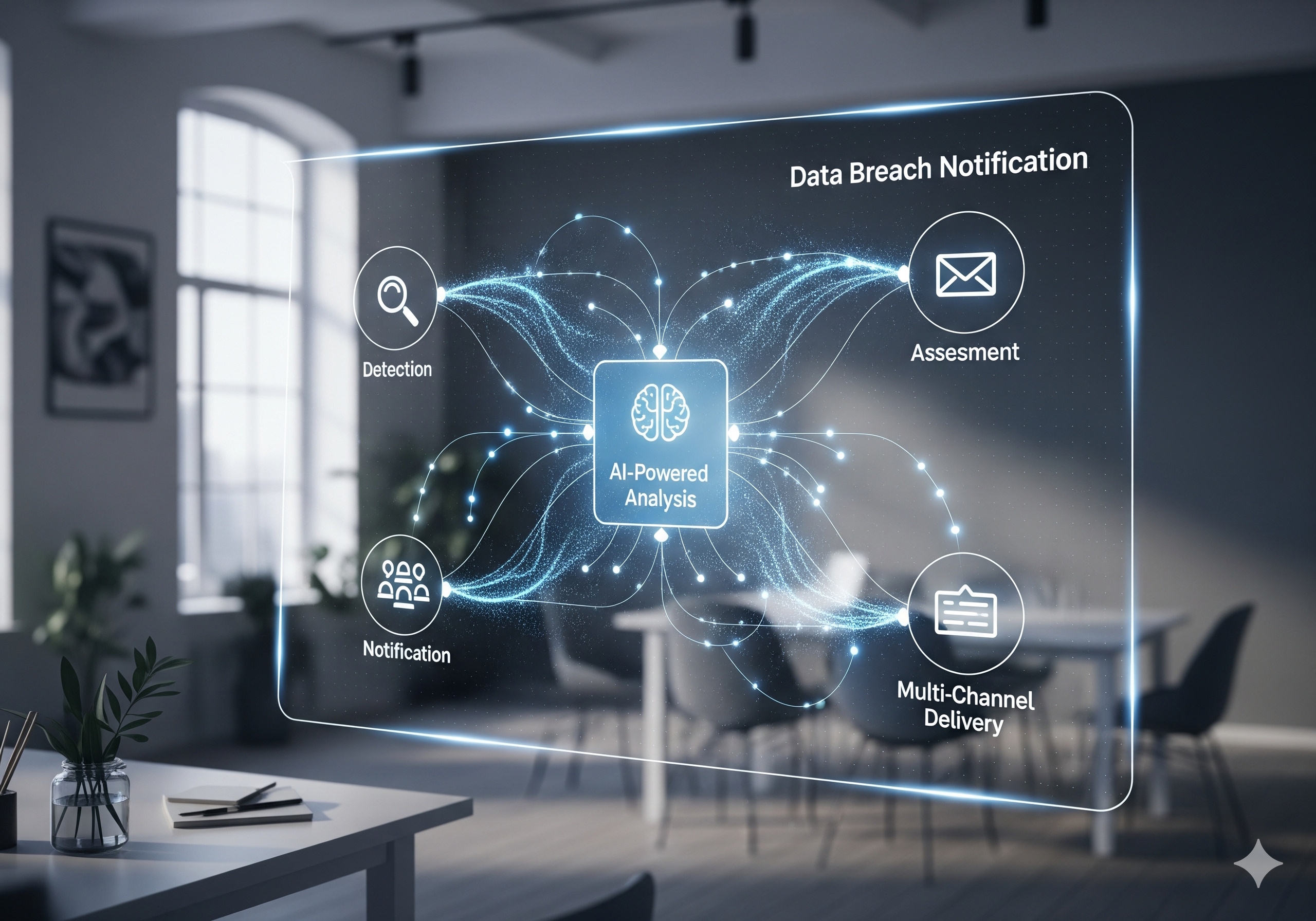Using A.I. for Data Breach Notifications: A Practical Guide for Attorneys
Data breaches demand swift, accurate, and compliant notification. For attorneys and privacy professionals, the challenge is not only determining who must be notified, but also meeting jurisdiction-specific timelines, tailoring content to statutory requirements, coordinating vendors, and maintaining a defensible record of decisions. Artificial intelligence (A.I.) can accelerate this work while reducing errors—if implemented responsibly.
This article explains how A.I. can support data breach notification programs across investigation, decisioning, drafting, translation, and proof-of-compliance. It highlights opportunities and risks, best practices for governance, recommended tools, and trends that will shape the next 12–24 months. The focus is practical: what to automate, what to supervise, and how to stay on the right side of regulators.
Table of Contents
- Introduction
- Key Opportunities and Risks
- Best Practices for Implementation
- Technology Solutions & Tools
- Industry Trends and Future Outlook
- Conclusion and Call to Action
Key Opportunities and Risks
Opportunities: Where A.I. Adds Value Today
Used with appropriate controls, A.I. streamlines the breach-notification lifecycle:
- Faster fact pattern triage: Summarize forensic reports, tickets, and logs to extract what data was involved, whose data it was, and whether it was accessed, acquired, or exfiltrated.
- Jurisdiction mapping: Link a fact pattern to applicable statutes (e.g., state breach laws, GDPR, HIPAA, GLBA, NYDFS) and identify timers and content requirements.
- Deadline calculators: Compute deadlines from discovery or determination dates and manage complex triggers (e.g., “without unreasonable delay,” “not later than 30 days”).
- Template drafting: Generate regulator notices, consumer letters, FAQs, call center scripts, and web notices that incorporate required elements.
- Translation and localization: Produce multilingual notices with jurisdiction-specific phrasing, plain-language readability, and dynamic insertion of call center numbers.
- List reconciliation: De-duplicate impacted individuals, validate addresses, and flag minors, employees, or residents of special jurisdictions.
- Proof-of-compliance: Assemble audit-ready files—timelines, drafts, approvals, and regulator communications—tagged to legal requirements.
Risks: What to Manage Proactively
- Confidentiality and privilege: Breach details are sensitive and often privileged. Sending data to external models without appropriate safeguards may waive privilege or violate DPAs.
- Accuracy and hallucination: Drafts may omit required elements (e.g., toll-free numbers) or misstate timelines. All outputs require human review.
- Bias and fairness: Translations and readability levels can inadvertently disadvantage certain populations; ensure inclusive, plain-language communication.
- Regulatory mismatch: Laws vary widely; a generic template may not satisfy content or timing requirements for a specific regulator.
- Data minimization: Over-ingestion of raw breach data increases risk. Use scoped datasets and contextual retrieval to limit exposure.
Opportunity–Risk–Control Matrix
| Opportunity | Primary Risk | Attorney Control |
|---|---|---|
| Automated jurisdiction mapping | Incorrect applicability determination | Require human-in-the-loop review and citation-backed outputs that link to statutes |
| Deadline calculation | Misapplied trigger date | Lock calculator to defined “discovery” vs “determination” inputs; dual-attorney sign-off |
| Notice drafting | Missing required elements | Use checklists mapped to each statute; automated completeness tests before release |
| Translation/localization | Ambiguity or legal misinterpretation | Back-translation verification and counsel approval for high-risk jurisdictions |
| List reconciliation | False matches; privacy leakage | Hashing/pseudonymization; deterministic matching rules with manual exceptions |
| Audit file assembly | Incomplete or non-reproducible records | Immutable logs, versioning, and retention policies aligned to regulation |
Where A.I. Fits in the Breach-Notification Lifecycle
| Phase | Typical Tasks | A.I. Capability | Attorney Oversight |
|---|---|---|---|
| Investigation | Review forensic memos, identify PII/PHI, confirm acquisition/exfiltration | Entity extraction, PII classification, summarization | Validate scope and facts, confirm legal definitions (e.g., “breach” vs “incident”) |
| Applicability | Map populations to jurisdictions, select statutes | Rules + retrieval-augmented Q&A over a maintained statute library | Resolve conflicts, apply client-specific thresholds |
| Decisioning | Assess notification thresholds and exceptions | Checklist reasoning with citations and confidence scoring | Final legal determination and risk acceptance |
| Drafting | Regulator and consumer notices, web posts, scripts | Template filling, tone control, merge fields, multilingual output | Legal review; ensure clarity and accuracy; privilege labeling |
| Distribution | Address validation, channel selection, tracking | De-duplication, bounce analysis, scheduling | Approvals for public statements and regulator submissions |
| Documentation | Audit file, timeline, regulator correspondence | Automated timeline generation, docketing, evidence linking | Final certification and preservation |
Compliance note: Deadlines and content vary widely. For example, GDPR generally requires notice to the supervisory authority within 72 hours of becoming aware, while many U.S. state laws run 30–45 days from determination. Always confirm the trigger and tolling events for each jurisdiction and regulator.
Best Practices for Implementation
Governance: Build Guardrails Before Automation
- Data protection and privilege: Use enterprise or on-premise A.I. with encryption, strict access controls, and contractual safeguards (e.g., DPA, SOC 2/ISO 27001). Disable vendor training on your data.
- Model selection: Prefer models that can run in a private environment or via trusted gateways. For highly sensitive matters, consider open-weight models deployed inside your tenant.
- Retrieval over raw prompts: Store statutes, regulator guidance, and firm templates in a maintained knowledge base. Use retrieval-augmented generation (RAG) so the model cites authoritative sources you control.
- Human-in-the-loop: Require attorney review for applicability decisions, deadlines, and final notices. Enforce approval workflows with role-based permissions.
- Logging and auditability: Capture prompts, sources, versions, reviewers, and timestamps. Immutable logs are invaluable in regulator inquiries and disputes.
- Change management: Establish a monthly or quarterly update cadence for legal content (statutes, guidance) and model prompts.
Ethical Use: Avoid Unintended Harm
- Accuracy first: Configure automated completeness checks (e.g., required statute elements) before any notice is cleared for release.
- Plain language: Ensure notices are understandable to the average consumer. Test readability and tone, not just legal sufficiency.
- Bias checks: Use back-translation and sampling across languages, dialects, and literacy levels. Solicit feedback from consumer advocates where appropriate.
- Data minimization: Redact or hash PII before uploading to A.I. whenever possible. Only ingest what the system needs for the task at hand.
A Sample, Defensible A.I.-Enabled Workflow
- Intake: Upload forensic summary and data dictionaries; system extracts facts and flags missing information.
- Applicability: A.I. proposes jurisdictions and statutes with citations; attorney approves or modifies.
- Deadlines: Calculator produces a jurisdictional timeline; partner review confirms triggers.
- Drafting: A.I. composes regulator notices, consumer letters, and website text from firm-approved templates.
- Translation: Back-translation loop verifies accuracy; counsel approves localization nuances.
- Distribution: List reconciled and addresses validated; schedules set; bounces monitored.
- Recordkeeping: System compiles an audit file including versions, approvals, and submission proofs.
Jurisdiction Trigger Deadline ----------------------------------------------------------- GDPR Awareness |██| 72 hours HIPAA Discovery |███████| 60 days NYDFS 500 Determination |██████| 30 days (to DFS) CA (CPRA/State) Determination |███████| 30–45 days SEC Reg S-P Discovery |██████| 30 days (proposed/varies)
Bars represent relative time from the specified trigger. Always confirm current statutory and regulatory requirements.
Minimum viable A.I. policy for breach work: (1) No client data leaves firm-controlled environments without written approval; (2) All automated decisions require attorney review; (3) All outputs must cite sources; (4) Maintain an audit trail of prompts, sources, and approvals.
Technology Solutions & Tools
While the topic is data breach notifications, it sits at the intersection of several familiar legal tech categories. The following tools can be combined into an end-to-end solution.
Document Automation
- Use for: Consumer letters, regulator notifications, FAQs, call center scripts, and public statements.
- Best features: Dynamic clause selection by jurisdiction; merge fields for incident details; automated completeness checks against statutory elements.
Contract Review
- Use for: Vendor and client agreements to extract notification timeframes, cooperation duties, and indemnity provisions that may override or add to statutory obligations.
- Best features: Clause extraction with confidence scoring, issue tagging, and side-by-side comparisons across vendor contracts.
eDiscovery and PII Discovery
- Use for: Identifying PII/PHI in compromised datasets; generating impacted individual lists.
- Best features: Entity recognition for names, SSNs, medical codes; data mapping; hashing for privacy-preserving processing.
Chatbots and Virtual Assistants
- Use for: Internal guidance to response teams; consumer-facing FAQs and post-notice inquiries.
- Best features: Guardrails to avoid individualized legal advice; answer provenance with links to firm-approved resources.
Vendor Capability Comparison (Illustrative)
| Capability | Why It Matters | Questions to Ask | Typical Indicators |
|---|---|---|---|
| Private/secure deployment | Preserves privilege and confidentiality | Can we deploy on-prem or in our tenant? Training disabled? | SOC 2/ISO 27001; tenant isolation; encryption-at-rest/in-transit |
| RAG over legal corpus | Factual accuracy and citations | How are statutes maintained and versioned? | Source-linked answers; update logs; jurisdiction filters |
| Deadline calculator | Timely compliance | Which triggers and tolling events are supported? | Configurable triggers; audit trail of inputs/edits |
| Template library | Speed and consistency | Jurisdiction-specific completeness checks? | Checklists with pass/fail before release |
| PII discovery | Accurate population identification | False positive/negative rates? Hashing support? | Benchmark metrics; pseudonymization by default |
| Audit trail | Defensible recordkeeping | Immutable logs? Export for regulator inquiries? | Time-stamped, versioned, exportable logs |
Build vs. Buy: A Simple Decision Frame
- Buy if: You need immediate capability, proven templates, and out-of-the-box regulator coverage.
- Build if: You require deep customization, unique client workflows, and full control over data/hosting.
- Hybrid approach: Use commercial components (PII detection, translation) behind a firm-controlled orchestration layer that enforces governance and logging.
Industry Trends and Future Outlook
Generative A.I. Matures for Regulated Work
Models are improving at structured tasks: checklist reasoning, citation grounding, and following schema. Expect better out-of-the-box support for statutory mappings and multilingual drafting—with diminishing hallucination rates when paired with curated corpora and deterministic checks.
Regulatory Landscape
- EU AI Act and national implementations will shape provider obligations, transparency, and risk management for legal A.I. tools.
- U.S. regulators (FTC, SEC, HHS/OCR, NYDFS) continue to clarify expectations for breach response, consumer communication, and documentation.
- NIST AI Risk Management Framework (RMF) is becoming a common reference for law firm and vendor governance.
- State privacy and breach laws remain dynamic; firms will favor solutions that maintain a living library of statutes and agency guidance.
Evolving Client Expectations
- Speed with accuracy: Clients expect counsel to deliver notifications faster without sacrificing defensibility.
- Cost transparency: Matter budgets increasingly require automation for drafting, translation, and list reconciliation.
- Integrated response: Clients want coordinated work across legal, forensics, PR, and notification vendors, with a single source of truth.
Privacy-Preserving Techniques
- Federated and on-device models reduce data exposure.
- Synthetic data and redaction pipelines enable safe prompt construction.
- Structured agents manage tasks like deadline tracking and QA while maintaining explicit, reviewable steps.
| Stage | Characteristics | Attorney Role |
|---|---|---|
| Templates | Static content, manual edits | Drafting and QA on every document |
| Guided Automation | Questionnaires, merge fields, checklists | Review key fields and final outputs |
| GenAI + RAG | Source-cited, jurisdiction-aware drafting | Approve applicability, deadlines, language |
| Agentic Systems | End-to-end orchestration with guardrails | Supervise decisions, handle exceptions |
Conclusion and Call to Action
A.I. will not replace legal judgment in breach notification, but it can dramatically improve speed, consistency, and defensibility. The most successful programs pair curated legal knowledge and robust governance with targeted automation—triage, applicability, deadline tracking, drafting, translation, and documentation—while keeping attorneys firmly in the loop.
Start small: pilot a secure, retrieval-augmented drafting toolkit around a narrow set of jurisdictions. Measure turnaround time, error rates, and client satisfaction. Then expand to deadline calculators, PII discovery, and integrated audit files. With the right guardrails, you can deliver faster notifications, clearer consumer communications, and a stronger record with regulators.
This article provides general information and is not legal advice. Always verify current statutes, regulations, and agency guidance for the relevant jurisdictions and industries.
Ready to explore how A.I. can transform your legal practice? Reach out to legalGPTs today for expert support.




